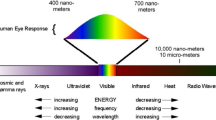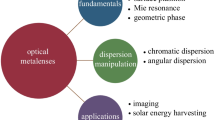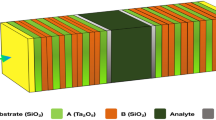Abstract
We used the finite difference time domain method to calculate scattering spectra for a multilayer nanoshell (MNS) consisting of a gold core, a molecular layer and a gold shell. The effects of geometrical parameters of the multilayer nanoshell (MNS) such as size, aspect ratio, the thickness of the shell and middle layer on the scattering properties of the MNS are investigated. We have also studied the plasmon-exciton coupling. In order to determine the coupling region, our numerical data are fitted to the coupled oscillator model. According to the obtained results, the plasmon-exciton coupling is found in the intermediate region. The plasmon-exciton coupling can be achieved and utilized as a sensor for sensing the refractive index changes. Variation of geometrical parameters of the multilayer nanoshell affects the strength of coupling and hence the sensitivity and detection accuracy of the sensor. The understanding of coupling mechanisms paves the way for the optimal design of the proposed sensor. We finally quantify and compare the performance of the sensor against previously introduced similar sensors.



















Similar content being viewed by others
References
P. Torma, W.L. Barnes, Strong coupling between surface plasmon polaritons and emitters: a review. Rep. Prog. Phys. 78, 013901 (2015)
D.M. Coles, N. Somaschi, P. Michetti, C. Clark, P.G. Lagoudakis, P.G. Savvidis, D.G. Lidzey, Polariton-mediated energy transfer between organic dyes in a strongly coupled optical microcavity. Nat. Mater. 13, 712–719 (2014)
N. Lundt, S. Klembt, E. Cherotchenko, S. Betzold, O. Iff, A.V. Nalitov, M. Klaas, C.P. Dietrich, A.V. Kavokin, S. Hofling et al., Room-temperature tamm-plasmon exciton-polaritons with a WSe2 monolayer. Nat. Commun. 7, 13328 (2016)
Y. Yu, Z.H. Ji, S. Zu, B.W. Du, Y.M. Kang, Z.W. Li, Z.K. Zhou, K.B. Shi, Z.Y. Fang, Ultrafast plasmonic hot electron transfer in au nanoantenna/MoS2 heterostructures. Adv. Funct. Mater. 26, 6394–6401 (2016)
A. Tsargorodska, M.L. Cartron, C. Vasilev, G. Kodali, O.A. Mass, J.J. Baumberg, P.L. Dutton, C.N. Hunter, P. Torma, G.J. Leggett, Strong coupling of localized surface plasmons to excitons in light-harvesting complexes. Nano Lett. 16, 6850–6856 (2016)
L.H. Lin, M.S. Wang, X.L. Wei, X.L. Peng, C. Xie, Y.B. Zheng, Photoswitchable rabi splitting in hybrid plasmon-waveguide modes. Nano Lett. 16, 7655–7663 (2016)
H.S. Lee, D.H. Luong, M.S. Kim, Y. Jin, H. Kim, S. Yun, Y.H. Lee, Reconfigurable exciton-plasmon interconversion for nanophotonic circuits. Nat. Commun. 7, 13663 (2016)
O. Jamadi et al., Polariton condensation phase diagram in wide-band-gap planar microcavities: GaN versus ZnO. Phys. Rev. B 93, 115205 (2016)
M. Wersall, J. Cuadra, T.J. Antosiewicz, S. Balci, T. Shegai, Observation of mode splitting in photoluminescence of individual plasmonic nanoparticles strongly coupled to molecular excitons. Nano. Lett. 17, 551–558 (2017)
M. Balasubrahmaniyam, D. Kar, P. Sen, P.B. Bisht, S. Kasiviswanathan, Observation of subwavelength localization of cavity plasmons induced by ultra-strong exciton coupling. Appl. Phys. Lett. 110, 171101 (2017)
G. Zengin, G. Johansson, P. Johansson, T.J. Antosiewicz, M. Kall, T. Shegai, Approaching the strong coupling limit in single plasmonic nanorods interacting with J-aggregates. Sci. Rep. 3, 3074 (2013)
S. Balci, E. Karademir, C. Kocabas, Strong coupling between localized and propagating plasmon polaritons. Opt. Lett. 40, 3177–3180 (2015)
A. Delga, J. Feist, J. Bravo-Abad, F.J. Garcia-Vidal, Quantum emitters near a metal nanoparticle: strong coupling and quenching. Phys. Rev. Lett. 112, 253601 (2014)
S.A. Maier, Plasmonics: Fundamentals and Applications (Springer, New York, 2007)
W.L. Barnes, A. Dereux, T.W. Ebbesen, Surface plasmon subwavelength optics. Nature 424, 824–830 (2003)
H. Rahman, H. Ali, I. Ahmad, R.U. Din, G.Q. Ge, Coherent control of surface plasmon polariton via spontaneously generated coherence. Eur. Phys. J. Plus 136, 267 (2021)
Y. Tang, X. Yu, H. Pan, J. Chen, B. Audit, F. Argoul, S. Zhang, J. Xu, Numerical study of novel ratiometric sensors based on plasmon-exciton coupling. Hal. 71, 2377–2384 (2017)
V. Krivenkov, S. Goncharov, I. Nabiev, Y.P. Rakovich, Induced transparency in plasmon-exciton nanostructures for sensing applications. Laser Photon. Rev. 13, 1800176 (2019)
T.J. Antosiewicz, S.P. Apell, T. Shegai, Plasmon-exciton interactions in a core−shell geometry: from enhanced absorption to strong coupling. ACS Photon. 1, 454–463 (2014)
H. Chen, L. Shao, KCh. Woo, J. Wang, H.Q. Lin, Plasmonic-molecular resonance coupling: plasmonic splitting versus energy transfer. J. Phys. Chem. C 116, 14088–14095 (2012)
Y. Hu, R.C. Fleming, R.A. Drezek, Optical properties of gold-silica-gold multilayer nanoshells. Opt. Express. 16, 19579 (2008)
A. Taflove, S. C. Hagness, Computational Electrodynamics: The Finite-Difference Time-Domain Method, Artech House, Norwood, (2005).
A. Mohammadi, F. Kaminski, V. Sandoghdar, M. Agio, Fluorescence enhancement with the optical (bi-) conical antenna. J. Phys. Chem. C 114, 7372–7377 (2010)
A. Mohammadi, F. Kaminski, V. Sandoghdar, M. Agio, Spheroidal nanoparticles as nanoantennas for fluorescence enhancement. Int. J. Nanotech. 6, 902–914 (2009)
A. Mohammadi, V. Sandoghdar, M. Agio, Gold nanorods and nanospheroids for enhancing spontaneous emission. New J. Phys. 10, 1–14 (2008)
S.V. Gaponenko, D.V. Guzatov, Colloidal plasmonics for active nanophotonics. Proc. IEEE 108, 704 (2020)
X. Wu, S.K. Gray, M. Pelton, Quantum-dot-induced transparency in a nanoscale plasmonic resonator. Opt. Express 13, 23633 (2010)
Author information
Authors and Affiliations
Corresponding author
Rights and permissions
About this article
Cite this article
Firoozi, A., Khordad, R., Mohammadi, A. et al. Plasmon-exciton interactions in a spheroidal multilayer nanoshell for refractive index sensor application. Eur. Phys. J. Plus 136, 1073 (2021). https://doi.org/10.1140/epjp/s13360-021-02094-4
Received:
Accepted:
Published:
DOI: https://doi.org/10.1140/epjp/s13360-021-02094-4




